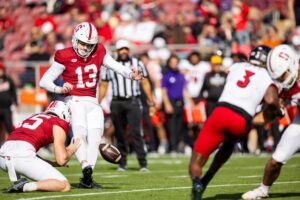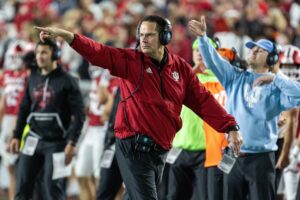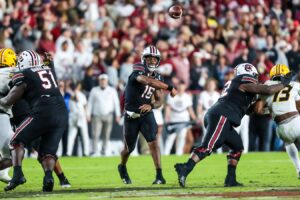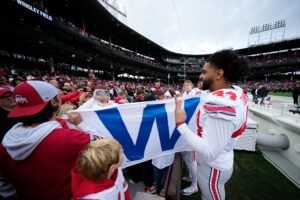Big things are expected from the Tennessee Volunteers this season. They enter the first week as a consensus Top 10 team, SEC East favorites, and riding the momentum of three straight seasons of improvement. But if the Vols are to reach their potential, one thing in particular must get better: Joshua Dobbs’ passing game. Specifically, the vertical passing game.
This statement won’t come as a surprise to Vol fans. What might come as a surprise, though, is just how much it needs to improve. Because of the play calling, Dobbs’ season stat lines are deceiving. You would think a quarterback with a 59.6% completion rate, 2291 yards, and a 15:5 Touchdown-to-Interception ratio would not have much room to improve. To understand the impact of a poor vertical passing attack on the Orange and White offense in 2015, just take a look at some key numbers.
INSIDE THE NUMBERS
As we said, Dobbs’ passing numbers were masked by the reliance of the short passing game all season. Dobbs’ passing “efficiency” numbers (completion percentage and percentage of completions that resulted in first downs) are actually good.


A completion rate of 59.6% and a first down rate of 58% easily puts Dobbs in the top half of the conference in 2015. In fact, his first down completion rate was third best. These numbers, however, are highly influenced by the reliance on outlet passes, swing passes, and short screen. Alvin Kamara and Jalen Hurd, Tennessee’s running back duo, were the second- and sixth-leading receivers in 2015. Hurd was only two receptions from being the fourth-leading receiver. That’s a staggering 27.3% of receptions from running backs.
Where Dobbs’ statistics start to break down is in the vertical passing game. On percentage of completions that resulted in receptions of 15-plus yards or more, Dobbs ranked eighth in the SEC with 28%. when you make that 25-plus yards, Dobbs ranked 12th at 8%. The latter category puts Dobbs in the same company as Missouri’s Drew Lock and Vanderbilt’s Johnny McCrary. For a team that wants to contend for a national title, that’s not the company you want to be in.

 But that’s not the worst part. The effect of such a dismal vertical passing game is realized late in games. Teams refuse to respect the deep threat and clamp down on the middle and underneath passing attack. Dobbs’ fourth quarter “clutch” stats should be the most alarming statistics from 2015 for Tennessee fans. Joshua Dobbs had no touchdown passes in the fourth quarter or overtime in the entire 2015 season. That, of course, ranks dead last in the SEC for 2015. Only two other quarterbacks, Patrick Towles from Kentucky and the afore-mentioned Johnny McCrary from Vanderbilt, also had more interceptions than touchdowns in the SEC in 2015.
But that’s not the worst part. The effect of such a dismal vertical passing game is realized late in games. Teams refuse to respect the deep threat and clamp down on the middle and underneath passing attack. Dobbs’ fourth quarter “clutch” stats should be the most alarming statistics from 2015 for Tennessee fans. Joshua Dobbs had no touchdown passes in the fourth quarter or overtime in the entire 2015 season. That, of course, ranks dead last in the SEC for 2015. Only two other quarterbacks, Patrick Towles from Kentucky and the afore-mentioned Johnny McCrary from Vanderbilt, also had more interceptions than touchdowns in the SEC in 2015.


 Joshua Dobbs is a popular player, and for good reason. He’s the epitome of the student-athlete. He’s active in the community and charity efforts. He’s a leader in the locker room. And he’s a great running quarterback. But for Tennessee to compete for championships, he must be better at the vertical passing attack in 2016.
Joshua Dobbs is a popular player, and for good reason. He’s the epitome of the student-athlete. He’s active in the community and charity efforts. He’s a leader in the locker room. And he’s a great running quarterback. But for Tennessee to compete for championships, he must be better at the vertical passing attack in 2016.
A CASE STUDY OF THE EFFECTS OF THE (ABSENCE OF A) VERTICAL PASSING ATTACK: OKLAHOMA
The 2015 Oklahoma game is the perfect example of how the absence of a vertical passing attack can undermine an otherwise good offense. Tennessee scored 17 first half points behind a strong and very impressive running attack. Oklahoma’s defense played the first quarter in a very standard, primarily two-deep defense with a four-man rush. An example of their formation is here:

They played this system for the majority of the first half. Only later in the second quarter, after going down 17-3, did Oklahoma shift their defensive strategy to stop the run. Here is the Sooner adjustment on the sixth series of the first half. At this point in the game, three of Tennessee’s first five drives had resulted in points and two of those series had eight plays or more. Oklahoma knew that they couldn’t let Tennessee keep grinding at that pace. They adjusted their defense to a one-deep safety and put an additional player in “The Box”. Additionally, from this point out, they had no less than seven men in “The Box” and rushed six men on almost every play. This, of course, comes at the risk of the deep pass.

In the first half, Tennessee had six full series (the seventh ended with halftime). There were 21 called runs and 17 called passes. Tennessee completed only six passes on those 17 pass play calls. In addition to seven incompletions, they had four pass play calls that ended up in either a sack or a quarterback run. Of their 13 actual passes nine were targets less than ten yards, three were targets between ten and 19 yards, and only one pass targeted a receiver beyond 20 yards from the line of scrimmage. In series six and seven (after the defensive adjustments), Dobbs was 0/6 on pass play calls and was pressured on four of those six play calls. His one vertical attempt at the half was a bad miss.
There’s no question the Oklahoma coaching staff went into halftime confident that their late first half adjustments were successful. If Tennessee was going to finish out the Sooners on this night, it was going to have to be Joshua Dobbs, not Jalen Hurd or Alvin Kamara.
Oklahoma’s second half was more of the last two series of the first half. Almost every play had eight men in the box, one-deep safety coverage, one-on-one with cornerbacks and a six or seven man rush. Tennessee was forced into five less run play calls because of the focus of the Sooner run defense. Here’s a look at a typical third quarter set from the Sooner defense.

Oklahoma has seven men in the box and rushes six. One safety is eleven yards deep. Continuing one of the trends of the night, Oklahoma takes risk not only deep, but over the middle. Tennessee was unable to exploit the inherent weaknesses in the Sooner formation during the entire second half.
Oklahoma simply wasn’t afraid of a pass beyond ten yards.
In the second half, Tennessee called 20 pass plays. Every aspect of the offense suffered from this absence of a vertical passing attack. Less runs. Less yards per rush. Less plays. Less plays per series. The passing stats were similar to the first half. Seven completions on twelve targets less than ten yards. No completions on three targets between ten and twenty yards. And no completions on one target over twenty yards.
This screen shot is a perfect example of how a vertical passing attack cripples an offense. It’s 3rd down and nine for the Vols, with 7:05 left in the game. Oklahoma has just scored their first touchdown and has all the momentum. Tennessee is in the midst of eight incompletions in nine pass targets. At this point, Tennessee almost has to have a first down. Most teams would be in a two deep zone with cornerbacks off the receivers. The goal is to keep everything under six or seven yards and then have plenty of defenders to make the tackle. Oklahoma, however, still rushes six men, with seven total in the box. The wide side cornerback and the nickel back are in straight man-to-man coverage. The free safety is helping underneath and against the short-side receiver.

It’s clear that the Sooners have absolutely no fear of a completed pass over ten yards from the Vol offense.
Tennessee fans know how this ends.
Many arguments can be made to acquit Dobbs’ passing in some form. Poor effort from the receivers? Line play? Play calling? Of course, the passing game isn’t just the quarterback.
But the pass at the end of the first half was a bad miss.
And this pass was 5 yards over the receiver:
And another overthrow:
For Tennessee to compete for championships, Joshua Dobbs has to throw better than that. You can’t expect for the coaches to continue to call deep pass plays with that small likelihood of success. Yes, the offensive line and receivers must play better as well. But in the above example, it’s Joshua Dobbs that needs the most improvement.
Certainly, Oklahoma was Dobbs’ worst passing performance of the season. Against Kentucky, he did exactly what he needed to do, hitting Josh Malone twice with deep strikes to force the Kentucky defense to play a little deeper. Tennessee’s offense moved at will against the Wildcats. But will Vol fans be happy beating teams like Kentucky and Missouri and Vanderbilt year-in and year-out?
WHAT WILL GET THE JOB DONE?
It’s easy to get discouraged. But Dobbs doesn’t have to win the game with his arm. He just needs to be a little bit better. In all the stats examined, only two quarterbacks in the SEC were in the top 8 in each category (Brandon Allen and Chad Kelly). The top four quarterbacks, by cumulative rank in those seven categories (Allen, Kelly, Jake Coker and Treon Harris), accounted for 42 wins last season, an average of 10.5 wins per quarterback. Here are the numbers Dobbs needs to hit for Tennessee to challenge at the highest echelons:
Completion Percentage: 62.5%
1st Down Percentage: 60%
% of Completions 15+: 33%
% of Completions 25+: 13%
4th QTR TD:INT Ration: 6:1
Of those statistics, reaching 33% of completions beyond 15 yards is the most important. This will force teams into a 2-deep safety coverage, which means Hurd and Kamara will have one less defender.
That type of performance will put Dobbs’ passing in the top third of vertical passing statistics. That, combined with a lethal running attack and what should be a top quarter defense, will put Tennessee in position for its first Conference Championship in 18 years.
If Dobbs can throw deep a little more effectively this year, the only pass Vol fans will care about at the end of the season is when their quarterback passes a championship trophy to his teammates.
h/t to YouTube member vol freak for the game footage at https://youtu.be/I45tU0GGc9k
All Stats used sourced from www.cfbstats.com (Dobbs’ Stats: http://www.cfbstats.com/2015/player/694/1057515/passing/gamelog.html)
Main Photo:
<div class=”getty embed image” style=”background-color:#fff;display:inline-block;font-family:’Helvetica Neue’,Helvetica,Arial,sans-serif;color:#a7a7a7;font-size:11px;width:100%;max-width:594px;”><div style=”padding:0;margin:0;text-align:left;”><a href=”http://www.gettyimages.com/detail/503768476″ target=”_blank” style=”color:#a7a7a7;text-decoration:none;font-weight:normal !important;border:none;display:inline-block;”>Embed from Getty Images</a></div><div style=”overflow:hidden;position:relative;height:0;padding:76.767677% 0 0 0;width:100%;”><iframe src=”//embed.gettyimages.com/embed/503768476?et=ibSqPpz7QdJPErQcu7_Ldw&viewMoreLink=on&sig=ZYdg3STloTStEAGBiKU49o3nIz5REaTSU4EX2SUnAfY=&caption=true” width=”594″ height=”456″ scrolling=”no” frameborder=”0″ style=”display:inline-block;position:absolute;top:0;left:0;width:100%;height:100%;margin:0;”></iframe></div><p style=”margin:0;”></p></div>






